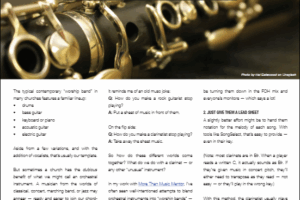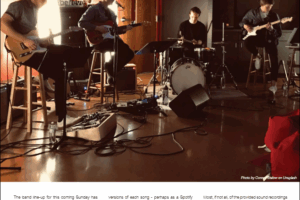Take this link to read Grant’s article as featured in the December issue of Worship…

VOCALISTS: TOP 10 TIPS FOR A BETTER OPEN SPEAKER MONITOR MIX (PART 1)
By Grant Norsworthy
After regularly finding themselves popping out one or even both in-ear monitors (IEMs) to get a better feel for the level of congregational connection, many Church vocalists and leaders of worship through songs are discovering (or rediscovering) the good things about open speaker monitors that may have been (nearly) forgotten.
Despite all the past efforts with “ambient” or “room” microphones (pointing toward the congregation so their “voice” can be fed back to those on the platform through IEMs), they are finding that nothing’s better than good ol’ fashioned floor wedges if (and it’s a big IF) they are used properly.
If we’re going to keep – or reintroduce – open speaker monitors, let’s do it well! Let’s NOT make the same mistakes that made IEMs seem like the only possible way forward in the first place. No one wants to return to the horrors of the open speaker monitor wars!
To that end, here’s my TOP 10 LIST of tips for vocalists to get a better open speaker monitor mix:
#10 POSITION
Monitor speakers are highly directional. Make sure that your monitor speaker enclosure is positioned in such a way that its “tube” of sound reaches your head in a direct line that is as short as practicable. You don’t want the bulk of the sound shooting past your shins, or off to one side. You should be able to look at the speaker and see it “looking” straight back at you.
#9 OBSTRUCTIONS
Don’t have anything like a music stand or tablet in the line between the monitor and your head. This can greatly and negatively affect the sound. The higher-frequency-producing “horn” of the speaker enclosure is particularly susceptible to this.
#8 ISOLATION
I hope it goes without saying, but you must do a sound check! And when you’re sound checking your monitor, there should be no competing sounds around you. To truly assess the quality and suitability of the monitor mix, eliminate any competing hubbub of instruments jamming, singers singing or even close-by talking.
I have found that it is super helpful to ask for the FOH system to be muted. The competing “room” sound can leave me confused about what I am hearing from my monitor. Empty rooms – especially big ones but also smaller ones – generally have a lot of boomy lower frequencies, especially before the congregation arrives. People soak up an enormous amount of that low-end wash. The sound of my monitor during sound check – in an empty room with the PA muted – is much closer to how it will sound during the service – with a crowd and the PA running.
#7 GET OVER IT!
If you haven’t yet had enough experience singing into a microphone, the sound check can be a nerve-racking, or even fear-inducing experience. “Oh no! Everyone’s listening! There are no other sounds to hide behind! Everyone will hear my voice for what it is!” As a result, when asked to check their microphone, a lot of church singers are WAY too tentative. A timid, mousey, “Check, one, two… yes that’s fine,” is not enough for a soundcheck. We have to get over it! Every singer has had to work through this. If your voice is good enough to be mic’ed, you must be able to do this: Sing into the mic in the same way whether it’s sound check or service. And sing with the loudest volume you will use in the service.
I’ve had great success helping singers break through this barrier by singing with them to begin with and, once they’re rolling, I slip away from my microphone and allow my voice to trail off to nothing. Most can keep going once they’ve made a start. The more they do it, the easier it gets.
#6 MIC TO MOUTH PROXIMITY
The dynamic microphones generally used for the human voice are designed to be positioned very close to the sound source. They are also highly direction-sensitive. Whether it’s on a mic stand or in your hand, always have the mic pointing straight towards your mouth and at about a finger’s depth from your lips. Don’t pull away from the mic (or pull the mic away from your mouth) when you’re going for that higher note, when you think you’re singing louder or you’re a bit unsure of yourself. Allow the audio tech to mix. Don’t try to mix yourself.
We’re half way there! For #5 to #1 of this list, make sure you check out PART 2 of this blog post here. The best is yet to come!
And watch this short video for a goofy demonstration of some of these tips.
This article was first published by Worship Tech Director of the WFX Network on February 7, 2019.


